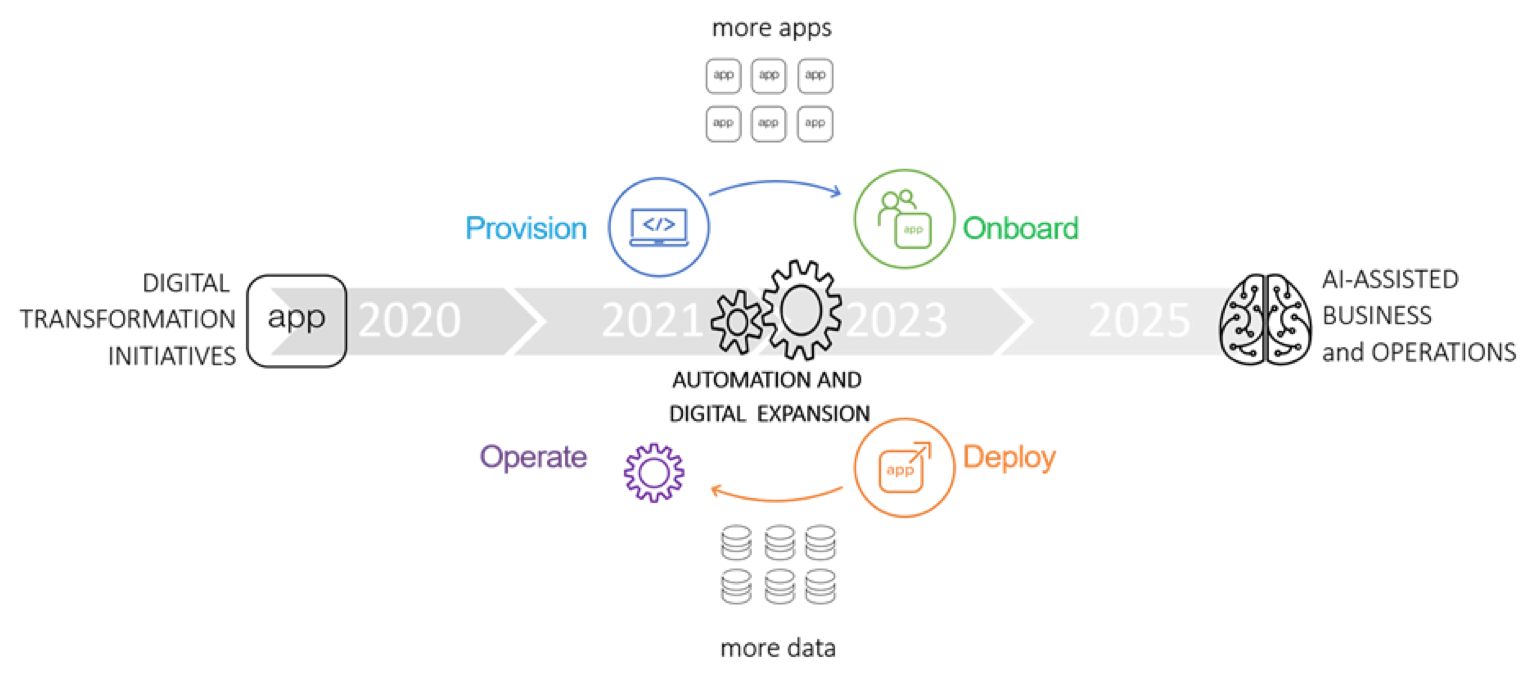디지털 변환: 2020년과 그 이후
모든 변형의 정의에는 변화라는 개념이 포함됩니다. 가장 흔한 예는 자연에서 애벌레에서 나비로, 올챙이에서 개구리로 변화하는 과정에서 찾을 수 있습니다. 궁극적으로 변형이란 한 상태에서 다른 상태로 옮겨가는 과정 입니다.
프로세스는 종종 중요한 이벤트가 발생하는 다양한 길이의 단계로 표현됩니다. 디지털 혁신도 예외는 아닙니다.
모든 것은 이니셔티브로부터 시작됩니다. 대부분 사람이 주도하는 수작업 사업에서 기술에 크게 의존하는 사업으로 전환하기로 한 결정입니다. 응용 프로그램. 자동화. 인공지능. 처음부터 끝까지 디지털 혁신은 기술을 비즈니스 상호작용에서 프로세스로, 그리고 새로운 모델로 옮기는 것입니다.
처음에는 앱에 관한 것입니다. 하지만 앱 포트폴리오가 확장되면서 자동화와 오케스트레이션에 중점을 두게 되었습니다. 데이터 생성이 증가함에 따라 혁신은 새로운 비즈니스 기회를 위한 중심점이 됩니다.
오늘날 거의 모든 조직은 미래의 성공을 위한 새로운 디지털 경로를 구축하면서 변화의 과정을 겪고 있습니다.

이러한 변화는 단지 기술에만 국한되지 않습니다. 이는 기업 운영 방식의 근본적인 변화에 기인합니다. 클라우드 컴퓨팅의 급속한 발전으로 인해 CapEx에서 OpEx로 전환된 것과 비슷하게, 이러한 변화는 기업이 비즈니스 모델을 재편하도록 강요하고 있습니다.
결과적으로 기술(IT)은 기업을 지원하는 역할에서 벗어나 기업을 주도하는 역할로 바뀌었습니다. BSA 재단에 따르면 앱을 포함한 소프트웨어는 2018년에 미국 GDP에 8,450억 달러를 직접적으로 기여했습니다. EU에서는 소프트웨어가 3,040억 유로를 기여했습니다. 세계 GDP에 대한 총 부가가치는 훨씬 높으며, 간접 수익과 일자리 창출을 모두 포함합니다. 모든 분야, 모든 산업은 이제 어떤 형태로든 응용 프로그램에 의존하고 있습니다.
여기에는 소비재를 생산하는 사업도 포함됩니다. OpenTable과 통합하지 않을 경우 레스토랑에 어떤 영향이 미치는지 생각해 보세요. 또는 사물인터넷과 '스마트 농장'을 구동하는 애플리케이션에 대한 의존성으로, 농업을 최적화하여 전 세계 사람들에게 식량을 공급할 수 있습니다. 이러한 산업들조차도 사업을 운영하기 위해 애플리케이션에 점점 더 의존하고 있습니다.
앱 경제
곧 발간될 2020년 애플리케이션 서비스 현황 보고서의 예비 데이터에 따르면 대부분 기업이 애플리케이션에 의존하는 것으로 나타났습니다. 31%는 앱이 필요하고, 다운타임이 비즈니스에 방해가 된다고 답했습니다. 또 다른 29%는 애플리케이션이 자사의 사업 이며 애플리케이션 없이는 운영이 불가능하다고 답했습니다.
디지털 혁신을 일찍 도입한 기업은 자동화를 빠르게 도입하고 앱 포트폴리오를 확장하는 등 디지털 확장 기간에 이미 진입하고 있습니다. 이러한 조직의 경우 애플리케이션 제공의 운영 측면을 간소화하는 것이 중요합니다. 시장에 출시하는 동안에도 새로운 애플리케이션이나 디지털 워크플로를 신속하게 개발할 수 있는 능력이 갖춰져야 합니다. 이 운영 라이프사이클의 속도와 규모는 개발되는 모든 애플리케이션에 따라 증가합니다. IT가 수요를 충족할 수 있는 능력은 자동화 도입을 통해서만 실현될 수 있으며, 이를 통해 조직은 더 많은 애플리케이션을 개발하고 배포할 수 있습니다.
데이터 경제
이 주기를 반복할 때마다 더 많은 데이터가 생성됩니다. 비즈니스 통합 서비스 제공업체인 도모(Domo)는 매일 2500조 바이트가 넘는 데이터가 생성되고, 2020년까지는 "지구상의 모든 사람에 대해 매초 1.7MB의 데이터가 생성될 것"이라고 보고했습니다 . 이는 애플리케이션이 운영에서부터 비즈니스 거래, 소비자 상호작용에 이르기까지 디지털 활동의 모든 세부 사항을 수집하고 집계함에 따라 데이터 경제의 문을 여는 엄청난 양의 데이터입니다.
기존의 데이터 분석 기술로는 따라잡을 수 없습니다. 매일 운영 및 비즈니스 결정을 내리기 위해 데이터에 의존하는 시스템과 사람들은 엄청난 부담을 겪게 될 것입니다.
그 결과, 새로운 종류의 분석이 등장하여 엄청난 속도와 방대한 양의 데이터를 분석하는 부담을 덜 받게 될 것입니다. 오직 기계와 고급 기계 학습 기술만이 생성되는 엄청난 양의 데이터를 수집하고 처리할 수 있을 것입니다.
AI 경제
결국, 분석을 통해 생성되는 통찰력은 그것을 생성한 데이터에서 생성되는 통찰력만큼이나 엄청날 것입니다. 운영자는 생성된 통찰력을 활용할 만큼 신속하게 조치를 취할 수 없습니다. 이는 AI 경제로 이어질 것이며, AI 지원 사업과 운영이 사업이 운영하는 애플리케이션을 운영하는 책임을 맡게 될 것입니다. 이러한 경제적 변화는 사소한 일이 아닐 것이다. 맥킨지에 따르면 "AI는 2030년까지 약 13조 달러의 추가 글로벌 경제 활동을 가져올 잠재력이 있으며, 현재와 비교해 약 16% 더 높은 누적 GDP를 창출할 수 있습니다." 그러니 2018년 초에 C 레벨 임원의 71%가 AI를 경제 성장과 경쟁력을 위한 길로 주목하고 있다는 사실은 놀라운 일이 아닙니다. ( 2018년 C-Suite의 견해: 도전에 임하다 )
AI에 대한 이런 관점은 단순한 희망이 아닙니다. Spiceworks의 2020년 IT 현황에 따르면 IT 의사결정권자의 74%가 이르면 2021년에 AI를 도입할 것으로 예상됩니다. 같은 조사에 따르면 AI는 IT 자동화(42%)에 이어 두 번째로 큰 영향을 미칠 기술로 꼽혔습니다(32%).
애플리케이션 서비스의 역할
오늘날 이러한 변화의 여정을 겪지 않은 기업은 사실상 없습니다. 어떤 사람들은 이제 막 시작 단계에 있습니다. 다른 사람들은 더 멀리 나아갔습니다. 어디에 있든, 천천히 꾸준히 전진하든 전진하든, 응용 프로그램은 전진하는 데 중요합니다. 이러한 애플리케이션을 제공하는 것이 애플리케이션 서비스의 관할 범위입니다. 코드에서 고객까지, 애플리케이션 서비스는 확장 가능하고 보안이 강화되며 오늘날 비즈니스를 뒷받침하는 애플리케이션을 제공합니다.
그들은 5년 후에도 여전히 그 역할을 수행하게 될 것입니다.
하지만 애플리케이션 아키텍처와 운영 모델이 애플리케이션과 비즈니스의 요구에 맞게 변화하는 것처럼 애플리케이션 서비스 역시 변화해야 합니다. 그래서 우리는 디지털 혁신을 통해 더욱 인식적이고, 더 자동화되고, 고급 분석을 통해 생성된 통찰력을 바탕으로 조치를 취할 수 있는 새로운 세대의 애플리케이션 서비스가 탄생할 것이라고 믿습니다.
